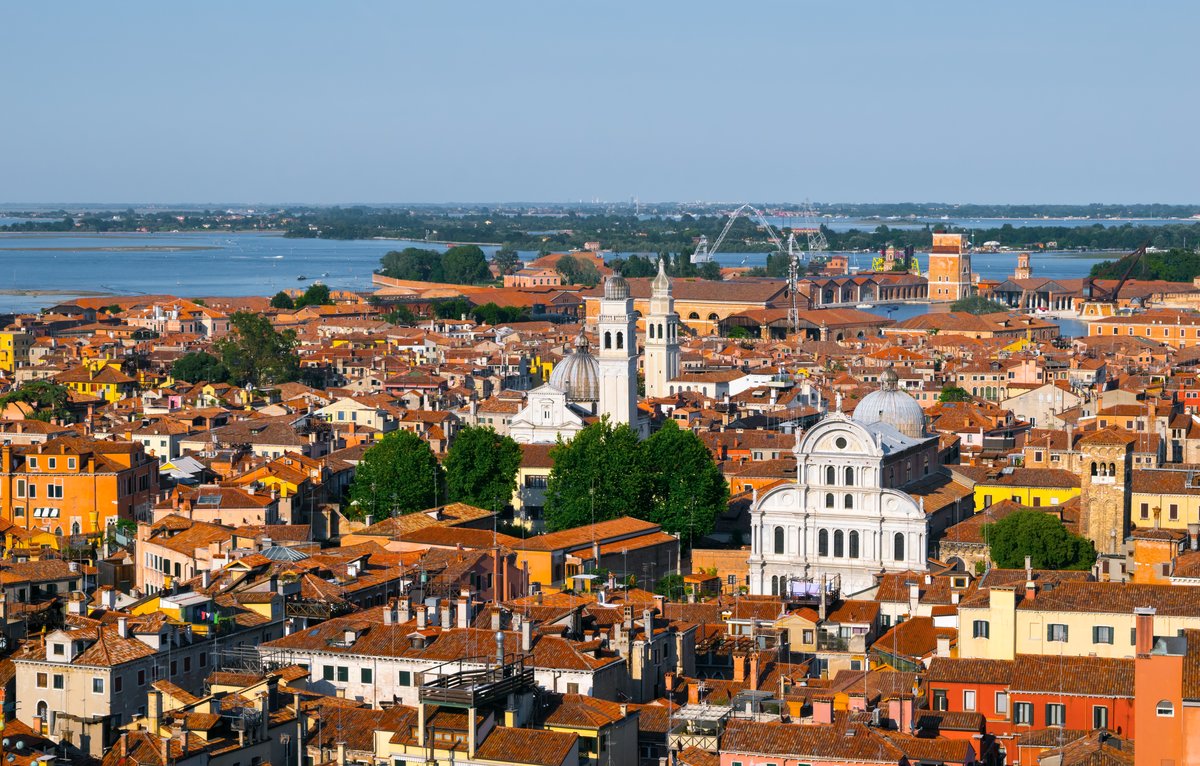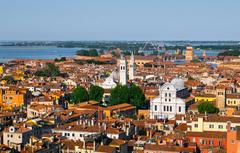
San Zaccaria Venice: Visiting Hours, Tickets, and Historical Sites Guide
Date: 14/06/2025
Introduction
San Zaccaria is one of Venice’s most compelling historic churches, renowned for its harmonious blend of Gothic and Renaissance architecture, magnificent artwork—most notably Giovanni Bellini’s famed altarpiece—and its unique, atmospheric crypt. Located just east of St. Mark’s Basilica, San Zaccaria provides a profound window into Venice’s layered religious, artistic, and civic history. This comprehensive guide covers its origins, architectural evolution, key artworks, visiting hours, ticketing, accessibility, and practical travel tips, ensuring an enriching experience for every visitor (Liturgical Arts Journal; Wikipedia).
Table of Contents
- Overview of San Zaccaria: Venice’s Historic Treasure
- Historical Origins and Early Development
- Architectural Features: Façade and Interior
- Religious and Civic Significance
- Artistic Heritage and Masterpieces
- The Flooded Crypt: A Unique Venetian Experience
- Visitor Information: Hours, Tickets & Tips
- Getting There: Location and Access
- Visitor Experience: Atmosphere, Crowds, Accessibility
- Practical Tips for Visiting
- Nearby Attractions and Events
- Frequently Asked Questions (FAQ)
- Summary and Key Points
- References and Official Resources
Overview of San Zaccaria: Venice’s Historic Treasure
San Zaccaria is a must-see for travelers seeking to explore Venice’s spiritual and artistic legacy. Founded in the 9th century to house the relics of Saint Zechariah—gifted by the Byzantine Emperor Leo V—the church quickly became a focal point for both religious devotion and civic life. Its current structure, a masterpiece of late Gothic and early Renaissance design, is celebrated for its luminous interior, serene atmosphere, and extraordinary artworks (Bonjour Venise). The partially flooded crypt, containing the tombs of early doges, is a haunting reminder of Venice’s unique relationship with water (Atlas Obscura).
Historical Origins and Early Development
San Zaccaria’s origins date to Venice’s formative years, when Doge Giustiniano Participazio founded a church and convent for noblewomen, cementing the city’s ties with Constantinople. The arrival of Saint Zechariah’s relics made it a major pilgrimage site and symbol of Venice’s spiritual and political ambitions. Over the centuries, the church underwent several reconstructions: the present edifice was built in the late 15th century, adjacent to the earlier Gothic church, whose remnants are still partially visible (Wikipedia; Bonjour Venise).
Architectural Features: Façade and Interior
Façade: Renaissance Harmony and Gothic Echoes
The façade, designed by Mauro Codussi, marks a pivotal moment in Venetian architecture. Its tripartite design, articulated with twin columns and tall windows, blends the verticality of the Gothic with the rationality and balance of the Renaissance. The lower section features polychrome marble in geometric patterns, while the upper level is crowned by a round arch and a statue of Saint Zechariah (Visit Venezia; Bonjour Venise).
Interior: Nave, Chapels, and Decorative Scheme
Inside, three naves are separated by robust columns, with white vaults and tall windows filling the space with light. Frescoes from the late 15th and early 16th centuries adorn the chapels and back walls, contributing to a contemplative and immersive artistic environment (Bonjour Venise).
Religious and Civic Significance
San Zaccaria was historically tied to one of Venice’s most prestigious Benedictine convents for noblewomen, reinforcing its status as a center for both spiritual life and the city’s elite. The abbess held considerable influence and maintained close ceremonial ties with the Doge, most notably during the annual Easter Monday visit when the Doge presented gifts and candles as a gesture of gratitude and civic-religious unity (Italy Magazine).
Several early doges are buried within the crypt, reflecting the intertwining of religious and civic history.
Artistic Heritage and Masterpieces
Giovanni Bellini’s San Zaccaria Altarpiece
The crowning jewel of San Zaccaria’s artistic patrimony is Bellini’s 1505 “San Zaccaria Altarpiece,” a serene vision of the Madonna and Child with saints, suffused with luminous color and subtle naturalism. This work profoundly influenced Venetian Renaissance art and set new standards for religious painting (eHarris Gallery).
Other Artistic Treasures
San Zaccaria also features works by Tintoretto, Palma il Giovane, Andrea del Castagno, and Tiepolo, as well as Gothic frescoes and numerous funerary monuments commissioned by Venice’s noble families (Alilaguna).
The Flooded Crypt: A Unique Venetian Experience
Architectural and Historical Features
Beneath the church lies the crypt—dating from the early 10th century—supported by Romanesque columns and housing the tombs of early doges. Venice’s high water table means the crypt is often partially submerged, creating a mesmerizing, mirror-like effect. This rare phenomenon offers an evocative glimpse into Venice’s perpetual negotiation with water (Atlas Obscura; The Travel Folk).
Visitor Experience
Access to the crypt requires a small fee, which supports ongoing preservation. The crypt’s semi-submerged state and atmospheric lighting make it a highlight for those interested in Venice’s hidden history (The Travel Folk).
Visitor Information: Hours, Tickets & Tips
-
Opening Hours:
- Monday to Saturday: 10:00 AM – 6:00 PM
- Sunday/Holidays: Closed or limited hours (often 4:00 PM – 6:00 PM)
- Special closures apply on January 1st, Easter, August 15th, December 25th (Venezia Unica).
-
Tickets and Admission:
- Main church: Free entry
- Museum, chapels, and crypt: Included with the Chorus Pass (Chorus Venezia)
- Chorus Pass: €12 (adults), €8 (students), €28 (families) for entry to 18 historic Venice churches (Venice Travel Guide)
-
Guided Tours:
- Available through local providers and often include San Zaccaria in broader itineraries (itinerary.expert).
-
Accessibility:
- The main church is accessible for visitors with limited mobility.
- The crypt and chapels require stairs and may not be suitable for all visitors.
- For specific needs, contact the church in advance.
-
Dress Code and Photography:
- Modest attire required (shoulders and knees covered).
- Photography permitted without flash except during services; check signage.
-
Best Time to Visit:
- Early morning or late afternoon for a peaceful atmosphere.
- The crypt is most accessible at low tide.
Getting There: Location and Access
- Address: Campo San Zaccaria, Castello district, Venice
- On Foot: 5-minute walk east from St. Mark’s Square
- By Vaporetto:
- San Zaccaria stop served by lines 1, 2, 4.1, and 5.1
- From Santa Lucia train station: lines 1 or 2 (Grand Canal, 46–48 min) or 4.1/5.1 (25 min) (Rick Steves’ Forum).
Tip: Vaporettos can be crowded—board at the route’s origin for the best seat (itinerary.expert).
Check AVM schedules or use the Chebateo app for real-time updates.
Visitor Experience: Atmosphere, Crowds, Accessibility
-
Atmosphere:
- San Zaccaria is quieter than most central churches, perfect for contemplation and art appreciation (visit-venice-italy.com).
-
Crowds:
- Busiest during late spring and early summer (midday).
- Off-peak: early morning or late afternoon; early spring and autumn offer tranquility.
-
Facilities:
- No public restrooms inside; facilities available at nearby cafes.
Practical Tips for Visiting
- Dress appropriately (cover shoulders and knees).
- Photography without flash is usually allowed but check for restrictions.
- Chorus Pass is recommended for multi-church visits and supports preservation (Chorus Venezia).
- Guided tours offer deeper historical and artistic insight—book in advance especially during peak seasons.
- Flooding: The crypt may be closed during acqua alta; check local conditions.
- Security: Be mindful of pickpockets near vaporetto stops.
Nearby Attractions and Events
- Piazza San Marco: 5-minute walk; visit the Doge’s Palace, St. Mark’s Basilica, and Campanile.
- Chiesa San Giorgio dei Greci: Greek Orthodox church nearby.
- Santa Maria della Pietà: Where Vivaldi taught music.
- San Giovanni in Bragora: Home to Cima da Conegliano altarpieces.
- Special Events: San Zaccaria occasionally hosts classical concerts—check schedules for unique experiences (visit-venice-italy.com).
Frequently Asked Questions (FAQ)
Q: What are San Zaccaria’s opening hours?
A: Monday–Saturday, 10:00 AM–6:00 PM; limited hours on Sundays/holidays.
Q: Is there an entrance fee?
A: Free for the main church; museum and crypt are included with the Chorus Pass.
Q: Is San Zaccaria wheelchair accessible?
A: The main church is accessible; the crypt and museum require stairs.
Q: Can I take photos inside?
A: Yes, without flash; restrictions may apply during services.
Q: How do I get there from the train station?
A: Take vaporetto lines 1 or 2 for a scenic journey, or 4.1/5.1 for a faster trip.
Summary and Key Points
San Zaccaria is a treasure of Venetian history and artistry. Its architectural evolution, from Byzantine-influenced origins to a harmonious Renaissance façade, mirrors the city’s own development. Highlights include Bellini’s renowned altarpiece, the evocative flooded crypt, and a setting rich in civic and spiritual symbolism. With free entry to the main church, accessible location, and practical visitor amenities, San Zaccaria is an essential stop for anyone wishing to experience the soul of Venice (Liturgical Arts Journal; Bonjour Venise; Atlas Obscura; eHarris Gallery).
References and Official Resources
- Liturgical Arts Journal: San Zaccaria Venice
- Wikipedia: San Zaccaria, Venice
- Bonjour Venise: San Zaccaria Venice Guide
- Atlas Obscura: The Flooded Crypt of San Zaccaria
- Italy Magazine: Church of San Zaccaria Venice
- Alilaguna: San Zaccaria Venice Info
- itinerary.expert: San Zaccaria Underground Museum
- Chorus Venezia Official Site
- Venezia Unica: Churches in Venice
- Rick Steves’ Europe Forum: Venice Arrival
- eHarris Gallery: Famous Paintings in Venice
- Our Escape Clause: Summer in Venice
- The Travel Folk: Hidden Gems in Venice
Images of San Zaccaria’s façade, interior artworks, and flooded crypt are available with descriptive alt tags at our gallery page. Interactive maps and virtual tours can be accessed via the Audiala app or our website.
Plan your visit with the Audiala app for guided tours, latest updates, and exclusive insights into Venice’s historic sites. For in-depth explorations of Venetian art and architecture, see our related articles: “Top 10 Historic Churches to Visit in Venice,” “Venice Vaporetto Guide: Routes and Tips,” and “Exploring Venice’s Renaissance Art Scene.”













































































































